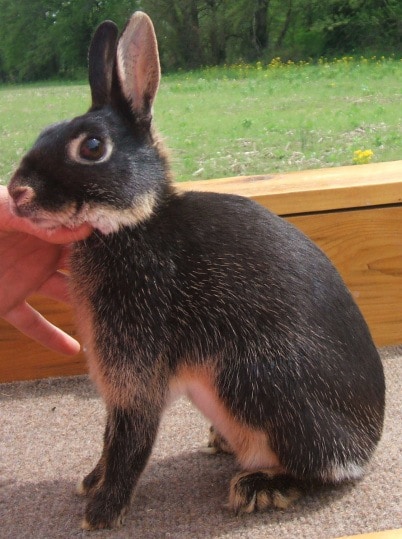Type the name of the breed you're looking for below
[wpdreams_ajaxsearchlite] Don't see the breed your're looking for? Click here and let us know!
Breed Characteristics
1 paw - breed exhibits the least amount of this characteristic
5 paws - breed exhibits most amount of this characteristic
Britannia Petite rabbit
| Origin | Sporting a classy body type, an attitude to match, and an array of beautiful colours, we have the other smallest breed, weighing a maximum of 2 ½ pounds when full grown. The “Brit,” as it is often called, is the only dwarf breed that is not supposed to be at all round or blocky in type. All efforts are made in the standard to keep the breed separate from the thickset Netherland Dwarf, as seen in the disqualifications for a rollback coat and for a blocky, “bulldog” head. A rabbit with a dewlap or ears over three inches should also be disqualified from competition. This breed is posed with its front toes just barely touching the ground, its chest elevated on long front legs and it’s topline curving smoothly to the tail. Plenty of “daylight” should show underneath the rabbit’s belly. Although posed similar to a Belgian Hare, the type is proportionally much shorter. The Brit has a flyback coat that comes in an interesting colour selection: black, chestnut agouti, black otter, sable marten, and REW. Ruby-eyed White (REW) was the original variety accepted by the ARBA in 1977. All the other colours currently recognized were developed by judge Rene Godderz, who is also currently presenting brokens and blue-eyed whites. There are many other colours in development, including blue otter and opal. The Britannia Petite, as its name suggests, originated in England, or rather, evolved there. By the late 1800’s the rabbit showing fancy had caught on in Britain, and the smallest white rabbits they had became known as “Polish.” At the turn of the century, the Polish breed was a compact-typed rabbit with a low headset. Polish were imported into the US by the early 1900’s, and here in America have remained essentially the same breed. However in England, breeders started teaching their Polish to sit up on their forefeet, and selected breeding stock with upright stances and refined bone. Soon their Polish had developed a completely different body type. The breed that Americans call the Brit is still known as the Polish by British Rabbit Council standards. When they were brought here in the 70’s, the name was changed because the ARBA already recognized a breed called Polish. The daintiest of rabbits, the Brit has a high-strung temperament. It takes an experienced and patient hand to work with them, but some breeders find it a delight. Britannia Petites must be trained to pose if they are to be successful on the show table. |
Physical Attributes
| Weight | 2.5 lbs. (1.1 kg) |
| Ear Type | Erect |
| Fur Type | Flyback |
| Colours | White, black, otter, chesnut, agouti (like a wild rabbit), and sable marten |
| Appearance | These tiny, compact rabbits have relatively narrow heads and a trim, arched body line. Ears are medium long and erect. |
| Other Considerations | Life Expectancy: 5-8 years Temperament: High strung, can be aggressive. Experienced rabbit breeders have claimed these rabbits have a tendency to be more hyper and nip more than other breeds and that they require especially careful handling because of the delicate arched body type. |



